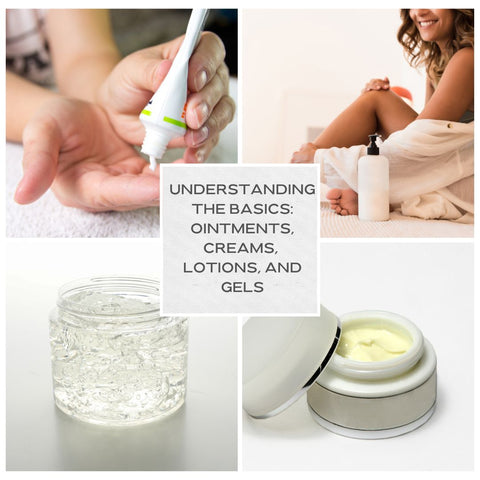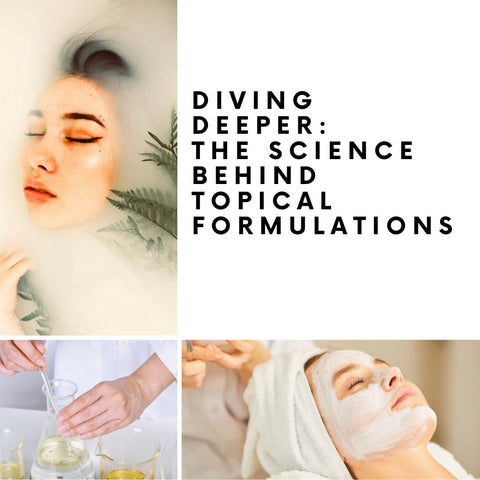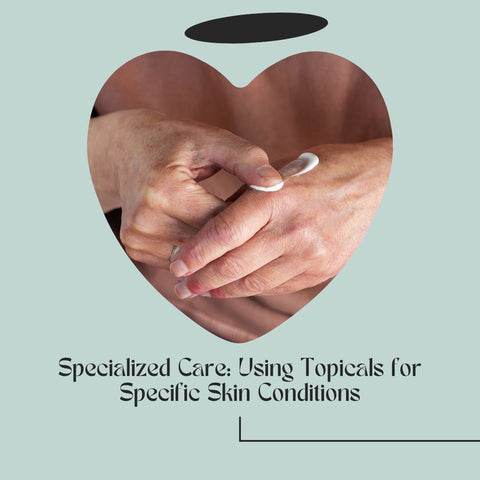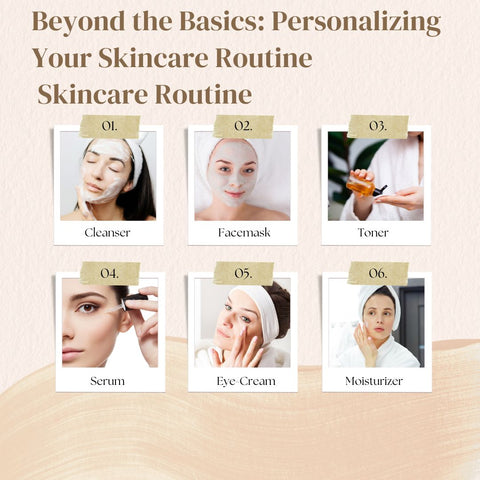Your skin type, the ailment you're treating, and personal choice all play a role in deciding whether to use an ointment, cream, lotion, or gel. This blog provides a quick overview to help you decide.
Let us delve into the world of skincare goods and discover the secrets behind ointments, creams, lotions, and gels. The ideal option for you depends on your skin type, issues, and preferences. Experimenting with different formulas will help you determine which works best for your skin's needs.
Understanding the Basics: Ointments, Creams, Lotions, and Gels

Let us examine these skincare formulations' fundamentals:
-
Ointments: These are oily, semi-solid gels that are usually made of a blend of waxes and oils. Ointments help to repair dry or damaged skin by creating a thick protective layer that stops moisture loss. They are particularly useful for very dry or irritated areas, such as elbows, knees, or heels. However, some people may find them too heavy or sticky for their skin, particularly if they have oily skin.
-
Creams: Compared to ointments, creams are lighter in consistency. They have a water base and are composed of a blend of oils and water that is frequently emulsified with an agent to give them a smooth texture. Creams deliver active ingredients to the skin and hydrate it at the same time. They are adaptable and work well with a range of skin types, including combination, normal, and dry skin. Creams can be applied to the entire body, including the face, and are frequently used for daily hydration.
-
Lotions: Compared to creams, lotions are more water-containing and lighter. They spread easily and are absorbed by the skin quickly. Typically, lotions are made of emulsifiers, water, and oils to produce a smooth, hydrating substance. Those who want a non-greasy feel and have normal to slightly dry skin can use them. Especially in warmer climates or during the summer, when heavier products may feel too occlusive, lotions are frequently used for daily hydration.
-
Gels: Gels are typically water-based and have a consistency similar to jelly. They have a clear, smooth texture because of the high concentration of water they contain along with stabilisers, thickeners, and active ingredients. Gels are lightweight, non-greasy, and quick-absorbing, making them ideal for oily or acne-prone skin types. They are often used for targeted treatments, such as acne gels, eye gels for reducing puffiness, or soothing gels for sunburns.
The Thick and Thin of It: Ointments for Deep Moisturization
When it comes to profound moisturization, ointments reign supreme in the skincare world. Here are some of the reasons why they are so effective: Emollient-rich, enhanced barrier function, skin condition treatment, and long-lasting hydration. While ointments provide unmatched moisturization, their thick and greasy texture may not be ideal for everyone, particularly those with oily or acne-prone skin. However, for those looking for intensive hydration and relief from dryness or skin issues, ointments are a tried-and-true remedy that provides deep, long-lasting moisture.
Creams: Balancing Hydration with Absorption
Creams strike a delicate balance between moisturising and being easily absorbed by the skin. Here's why they are popular among many:
-
Hydration: Creams hydrate the skin by combining water and oils, as well as emulsifiers and humectants. The water content moisturises and hydrates the skin, while the oils nourish and seal in moisture. This combination makes creams effective at keeping the skin soft, supple, and hydrated all day.
-
Emollient Properties: Emollient ingredients like glycerin, shea butter, and ceramides are commonly found in creams and help to soften and smooth the surface of the skin. These ingredients replenish the skin's natural lipid barrier, which can be compromised by factors such as harsh weather, environmental stressors, or age. By restoring the skin's barrier function, creams help to prevent moisture loss and maintain optimal hydration levels.
-
Easily Absorbable: Although creams are thicker than gels and lotions, they are still quite light and absorb into the skin rather quickly. Creams' emulsifiers aid in blending the oil and water phases to produce a smooth texture that absorbs and spreads easily. This makes creams suitable for daily use, including on areas of the body that require more frequent application, such as the hands or face.
-
Versatility: Creams are adaptable skincare items that can be customised to meet the needs and types of skin. They are available in a variety of formulations, such as oil-free creams for oily or acne-prone skin, rich creams for dry or mature skin, and lightweight creams for normal or combination skin. For added skincare benefits, creams can also be formulated with extra ingredients like vitamins, antioxidants, or SPF.
Lotions: Lightweight Hydration for Everyday Use
Lotions are excellent choices for light hydration in your daily skincare routine. Here's what makes them so popular:
-
Lotions have a higher water content than creams and ointments, resulting in a lighter consistency. This makes lotions easy to apply and quickly absorb into the skin, leaving a smooth, non-greasy finish. Their lightweight texture makes them ideal for everyday use, especially in hot weather or for people who have normal to slightly dry skin and prefer a lighter feel.
-
Despite their lighter texture, lotions provide adequate hydration to the skin. They typically contain a combination of water, oils, and humectants such as glycerin or hyaluronic acid, which draw moisture to the skin and help to keep it there. This helps to keep the skin hydrated, soft, and supple all day without feeling heavy or greasy.
-
Lotions are versatile skincare products that can be applied to the face and body. They are available in a variety of formulations to suit different skin types and needs, ranging from basic daily moisturisers to specialised treatments for specific concerns such as sensitive skin, acne-prone skin, and ageing skin. There is a lotion for everyone, with options ranging from fragrance-free to scented, oil-free to hydrating.
-
Lotions are simple to incorporate into your skincare regimen. Their lightweight texture allows them to be used on large areas of the body, including the arms, legs, and torso, as well as the face. They can be used after cleansing or showering and are easily absorbed into the skin through gentle massaging motions. In addition, many lotions come in convenient pump or squeeze bottles for easy dispensing.
Diving Deeper: The Science Behind Topical Formulations

The science of topical formulations is complex, involving ingredients, delivery systems, and skin physiology. Here's a deeper look at the key elements:
-
Topical formulations are meticulously crafted using a variety of active and inactive ingredients to achieve specific skincare objectives. These ingredients may include moisturisers (such as humectants, emollients, and occlusives), vitamins, antioxidants, botanical extracts, peptides, and others. Each ingredient is chosen for its intended function, whether it is hydrating the skin, reducing inflammation, increasing collagen production, or protecting against environmental damage.
-
The efficacy of topical formulations is frequently determined by their delivery methods, which govern how well active chemicals penetrate the skin barrier. Delivery systems can range from simple emulsions (such as creams and lotions) to more complex technologies like liposomes, nanoparticles, and microencapsulation. These delivery systems serve to improve the stability, solubility, and bioavailability of active substances, ensuring they reach their intended location inside the skin's layers.
-
The skin is a complex barrier that controls the movement of chemicals into the body. Topical formulations must overcome this barrier to efficiently deliver active components. Skin penetration is influenced by several factors, including the molecular size of the substances, their lipophilicity (ability to dissolve in fats), and the condition of the skin barrier. Formulators frequently use penetration enhancers, such as surfactants or lipid-based carriers, to boost active ingredient distribution to the skin.
-
Topical formulations must be stable over time to preserve efficacy and safety. pH, temperature, light exposure, and oxygen exposure all have an impact on skincare product stability. Formulators utilise strategies such as pH modification, antioxidants, preservatives, and container design to ensure the stability of their formulations throughout time.
-
The efficacy of topical formulations is evaluated through clinical studies, which assess their effects on the skin using objective measurements and subjective evaluations. These studies may include tests for hydration, elasticity, wrinkle reduction, pigmentation, and barrier function. By gathering scientific evidence of their efficacy, skincare companies can provide consumers with confidence in the effectiveness of their products.
Gel Formulations: Quick Absorption for Oily Skin
Gel formulations are ideal for people with oily skin because they are lightweight, non-greasy, and absorb quickly. Here's why they are ideal for oily skin types:
-
Water-Based Formulation: Gels are typically water-based, which means they contain a high proportion of water and little oil. This lightweight, aqueous base makes gels feel refreshing and non-greasy on the skin, making them ideal for people who produce excess oil.
-
Quick Absorption: One of the primary benefits of gel formulations is their rapid absorption into the skin. Gels have a thin consistency, allowing them to spread and absorb quickly, leaving a matte or semi-matte finish. This makes them ideal for oily skin types because they hydrate without adding shine or heaviness to the skin.
-
Oil-Free Hydration: Since gels are primarily water-based and contain minimal to no oil, they provide hydration without adding additional oils to the skin. This is especially useful for people with oily or acne-prone skin who are concerned about clogged pores or exacerbating their oiliness. Gels deliver lightweight moisture to the skin, helping to maintain hydration levels without contributing to excess oiliness.
-
Targeted Treatments: Gels are adaptable formulations that can be used to target specific parts of the face or body. For example, acne gels containing salicylic acid or benzoyl peroxide can be used directly on blemishes to help reduce inflammation and outbreaks. Eye gels can help minimise puffiness and dark circles under the eyes, while soothing gels can relieve sunburn or irritated skin.
-
Mattifying Effect: Some gel compositions are specifically developed to have a mattifying impact on the skin, reducing shine and oiliness throughout the day. These mattifying gels frequently include substances such as silica or powders, which assist in absorbing excess oil and leave the skin smooth and shine-free.
Choosing Between Water-based and Oil-based Products
A variety of factors influence your decision to use water-based or oil-based products, including your skin type, specific skincare needs, and personal preferences. Here's a breakdown to help you decide:
Water-Based Products:-
Water-based products are lighter in texture and usually oil-free, making them ideal for people who have oily or acne-prone skin. They hydrate the skin without adding any extra oil, which helps to control shine and reduces the risk of clogging pores.
-
Water-based products absorb quickly into the skin, leaving a light, non-greasy feel. This makes them ideal for daytime use because they do not leave a heavy or sticky residue on the skin.
-
Water-based products are excellent for hydrating the skin because they contain a high concentration of water and humectant ingredients such as hyaluronic acid or glycerin. They help to attract moisture to the skin and keep it hydrated throughout the day.
-
Water-based products frequently provide a refreshing and cooling sensation when applied to the skin, making them especially appealing in hot weather or after physical activity.
Oil-Based Products:
-
Oil-based products are richer and more emollient, making them ideal for individuals with dry or mature skin. They provide intense hydration and help to nourish and soften the skin, making it feel smooth and supple.
-
Oil-based products create a protective barrier on the skin's surface, helping to seal in moisture and prevent water loss. This makes them particularly effective for providing long-lasting hydration, especially in cold or dry climates.
-
Oil-based products have a higher concentration of emollient ingredients that soften and soothe the skin. They are excellent for treating rough or flaky skin and can gradually improve its texture.
-
Oil-based products can help repair and strengthen the skin's natural barrier function, which may be compromised by environmental stressors or ageing. They help to protect the skin from external aggressors while also maintaining its overall health and resilience.
Enhancing Treatment: The Role of Medication in Topicals
The use of medication in topical skincare products varies depending on the condition being treated and the desired outcome. Here are some ways to incorporate medication into topical treatments to improve their effectiveness:
-
Treatment of Skin Conditions: Many topical skincare products include medications that are intended to treat specific skin conditions such as acne, eczema, psoriasis, rosacea, and fungal infections. These medications may contain corticosteroids, retinoids, antibiotics, antifungals, or other active ingredients that work to treat the underlying cause of the illness and lessen its symptoms.
-
Anti-Inflammatory Effects: Topical treatments frequently employ medications like corticosteroids or nonsteroidal anti-inflammatory drugs (NSAIDs) to soothe irritated skin and reduce inflammation. These medications function by reducing the body's inflammatory response, which helps lessen discomfort and symptoms like swelling, redness, and itching.
-
Antibacterial and Antifungal Properties: A few topical drugs have ingredients that fight microbial infections on the skin's surface, such as antibacterial or antifungal agents. These medications may be useful in the treatment of bacterial folliculitis, fungal infections (such as ringworm or athlete's foot), acne, and secondary infections resulting from wounds or injuries to the skin.
-
Promotion of Skin Renewal: Topical treatments frequently include medications such as retinoids or alpha hydroxy acids (AHAs) to encourage skin renewal and exfoliation. These drugs function by promoting cell turnover, which unclogs pores, helps get rid of dead skin cells, and enhances the tone and texture of the skin. They can be useful in treating hyperpigmentation, fine lines and wrinkles, acne, and other indications of sun damage or ageing.
-
Pain Relief: Topical medications that contain analgesic agents, like menthol or lidocaine, can temporarily relieve pain for ailments like insect bites, sunburns, and muscle soreness. These medications function by numbing the skin's nerve endings, which lessens the perception of pain and discomfort.
-
Combination Therapy: Topical treatments frequently involve a mix of drugs that function in concert to address various facets of a skin condition. A topical acne treatment, for example, may contain antibacterial agents to kill acne-causing bacteria as well as anti-inflammatory agents to reduce redness and inflammation.
Specialized Care: Using Topicals for Specific Skin Conditions

Topical skincare products play an important role in providing specialised care for a variety of skin disorders. Here's how they can be applied to specific concerns:
-
Acne: Topical acne treatments frequently contain benzoyl peroxide, salicylic acid, retinoids (such as tretinoin or adapalene), and antibiotics (such as clindamycin or erythromycin). These ingredients help to clear clogged pores, reduce inflammation, kill acne-causing bacteria, and promote skin renewal. For more severe cases of acne, combination therapies such as benzoyl peroxide and a topical antibiotic or retinoid are frequently used.
-
Eczema: Emollients, corticosteroids, calcineurin inhibitors (like tacrolimus or pimecrolimus), or barrier repair creams are commonly used topical treatments for eczema. Emollients provide moisture and relief from dry, itchy skin, while calcineurin inhibitors and corticosteroids lessen inflammation and associated symptoms. By preventing moisture loss and lowering the chance of flare-ups, barrier repair creams support the skin's natural barrier function.
-
Psoriasis: Corticosteroids, coal tar, anthralin, retinoids (like tazarotene), and vitamin D analogues (like calcipotriene) are examples of topical treatments for psoriasis. These medications help to slow down skin cell growth, reduce inflammation, and relieve symptoms such as redness, itching, and scaling. To improve efficacy, combination therapies such as corticosteroids and vitamin D analogues or retinoids are frequently used.
-
Rosacea: Metronidazole, azelaic acid, sulfacetamide, brimonidine, or ivermectin are some possible topical treatments for rosacea. These medications help to reduce redness, inflammation, and visible blood vessels associated with rosacea. They also aid in the management of pustules and papules that can develop in certain rosacea types.
-
Hyperpigmentation: Ingredients like hydroquinone, kojic acid, azelaic acid, vitamin C, niacinamide, or alpha hydroxy acids (AHAs) are frequently found in topical treatments for hyperpigmentation. These components contribute to a more even skin tone and decreased pigmentation by preventing the synthesis of melanin, removing pigmented cells from the skin, and encouraging skin renewal.
-
Dry Skin: Emollients, humectants, occlusives, and ceramides are common topical treatments for dry skin. These ingredients help to hydrate, nourish, and repair the skin's natural barrier function, reducing moisture loss and restoring suppleness. Depending on the severity of the dryness, formulations can range from light lotions to rich creams or ointments.
To achieve the best results with topical treatments for specific skin conditions, it is critical to follow the instructions provided by a healthcare professional and to apply them consistently. Additionally, some medications may cause side effects or interactions, so any concerns should be discussed with a healthcare provider.
Eczema and Psoriasis: Ointments and Creams for Relief
Psoriasis and eczema are chronic skin conditions that need to be managed continuously, and creams and ointments are essential for relieving symptoms. This is where these formulations come in handy:
-
Ointments for Eczema and Psoriasis:
-
Emollients and occlusive agents, like mineral oil or petrolatum, which form a protective layer on the skin's surface, are abundant in ointments. This barrier helps to retain moisture, soothe dryness, and prevent irritation, making it especially useful for people who have eczema or psoriasis.
-
Ointments have a thicker consistency than creams and lotions, allowing for more intense hydration of the skin. This is especially useful for people who have severe dryness or thickened plaques caused by psoriasis.
-
Some eczema and psoriasis ointments contain corticosteroids or calcineurin inhibitors, which help to relieve the itching, inflammation, and redness associated with these conditions. These medications suppress the immune response and decrease the activity of inflammatory cells in the skin.
-
Creams for Eczema and Psoriasis:
-
Creams are lighter in texture than ointments but still provide adequate hydration to the skin. They are made up of a combination of water and oils, as well as emulsifiers, which allow them to spread easily and quickly penetrate the skin. Creams are appropriate for people who have mild to moderate eczema or psoriasis and prefer a lighter texture on their skin.
-
Creams may contain corticosteroids, calcineurin inhibitors, or other anti-inflammatory agents to reduce inflammation and alleviate symptoms such as itching and redness. These medications are frequently used in conjunction with moisturising agents to provide both hydration and relief from eczema or psoriasis flare-ups.
When deciding between ointments and creams for eczema and psoriasis relief, it is critical to consider the severity of symptoms, personal preferences, and skin type. Some people prefer ointments for their richness and long-lasting hydration, whereas others find creams more comfortable and easy to apply. Furthermore, following a healthcare professional's recommendations and using these topical treatments as directed is critical for achieving the best results and minimising the risk of side effects.
Acne-Prone Skin: The Advantage of Gels
Gels provide several benefits to people with acne-prone skin as part of their skincare routine.
-
Lightweight and Non-Greasy: Gels are perfect for skin prone to acne because of their non-greasy, lightweight texture. They are suitable for daily use, especially under makeup or sunscreen, because they absorb into the skin quickly and do not leave a heavy or sticky residue.
-
Oil-Free Formulation: A lot of gels are oil-free, which is good for skin that breaks out easily from acne because too much oil can clog pores. Oil-free gels help to keep pores clear and reduce the chance of acne flare-ups while providing hydration and other skincare benefits without adding extra oil to the skin.
-
Targeted Treatment: Gels enable the targeted treatment of blemishes and breakouts by being applied directly to facial or body regions that are prone to acne. They deliver active ingredients like retinoids, salicylic acid, and benzoyl peroxide that help to unclog pores, reduce inflammation, and kill acne-causing bacteria by penetrating deeply into the skin.
-
Mattifying Effect: Throughout the day, certain gels help to control shine and excess oil by having a mattifying effect on the skin. These mattifying gels are perfect for people with oily or combination skin because they contain ingredients like silica or powders that absorb oil and leave the skin with a smooth, matte finish.
-
Reduced Risk of Pore Clogging: This is crucial for skin that is prone to acne because gels are less likely to clog pores than heavier formulations like creams or ointments. People with acne-prone skin can hydrate and nourish their skin without aggravating existing breakouts by selecting a lightweight gel.
Anti-Aging Treatments: What Works Best for Mature Skin?
Several anti-aging treatments can help mature skin by targeting signs of ageing like wrinkles, fine lines, sagging, and uneven tone. Here are some treatments that are effective for mature skin:
-
Retinoids: Vitamin A derivatives such as retinol, retinaldehyde, and prescription-strength tretinoin are highly effective at improving skin texture and reducing the appearance of wrinkles and fine lines. They work by increasing cell turnover, stimulating collagen production, and promoting skin renewal. Retinoids can also help to fade dark spots and improve skin tone.
-
Peptides: Peptides are short chains of amino acids that help to stimulate collagen production and improve skin firmness and elasticity. Peptide-based skincare products can help to reduce the appearance of wrinkles and fine lines, as well as promote a more youthful complexion.
-
Hyaluronic Acid: Hyaluronic acid is a humectant that attracts and retains moisture in the skin, plumping fine lines and wrinkles while improving overall hydration. Hyaluronic acid-based serums and moisturisers can help mature skin retain moisture, making it appear smoother and more supple.
-
Antioxidants: Vitamin C, E, and green tea extract all help to neutralise free radicals and protect the skin from oxidative stress and environmental damage. Antioxidant-rich skincare products can help to improve skin texture, reduce wrinkles, and promote a more youthful appearance.
-
Alpha Hydroxy Acids (AHAs): Chemical exfoliants like glycolic acid and lactic acid help to remove dead skin cells and promote cell turnover. They can improve skin texture, minimise fine lines and wrinkles, and fade dark spots and hyperpigmentation. AHAs also help to hydrate the skin and boost its radiance.
-
Sunscreen: Sunscreen is essential for protecting mature skin from the harmful effects of UV radiation, which can accelerate the aging process and cause wrinkles, sagging, and uneven tone. Using a broad-spectrum sunscreen with SPF 30 or higher every day can help to prevent further damage and maintain a youthful appearance.
Beyond the Basics: Personalizing Your Skincare Routine

Personalising your skincare practice entails adapting it to your unique skin type, issues, preferences, and lifestyle circumstances. Here's how you can go beyond the basics to create a personalised skincare routine that addresses your specific needs: identify your skin type, assess your skin concerns, understand product ingredients, experiment with different products, customise your routine, listen to your skin, consult with a professional, and consistency is essential. Personalising your skincare routine ensures that your skin receives the care and attention it requires to look and feel its best. To attain the best results, experiment with different products, listen to your skin and make adjustments to your routine.
Sensitive Skin: Finding Your Perfect Match
For people with sensitive skin, finding the right skincare products can be a delicate balancing act. Here are some suggestions to assist you in discovering products that are suitable for your sensitive skin:
-
Look for products that do not contain harsh or irritating ingredients like fragrances, alcohol, sulphates, parabens, or synthetic dyes. Choose products labelled "fragrance-free," "hypoallergenic," or "for sensitive skin" to reduce the risk of irritation.
-
Look for gentle, non-irritating formulations made specifically for sensitive skin. These products are typically made with soothing ingredients like aloe vera, chamomile, oatmeal, and ceramides, which help to calm and hydrate the skin without irritating.
-
Before applying a new skincare product to your entire face, patch-test it on a small area of skin (such as the inside of your wrist or elbow) to see how it reacts. Wait 24-48 hours before checking for signs of redness, itching, burning, or irritation.
-
Keep your skincare routine simple and avoid using too many products, particularly those containing active ingredients or strong formulations. Use gentle cleansers, moisturisers, and sunscreen, and avoid products with multiple fragrances or complex ingredient lists.
-
Exfoliating products, such as scrubs, peels, and harsh cleansers, should be avoided because they can remove the skin's natural oils and aggravate sensitivity. Choose gentle exfoliants, such as enzyme-based or chemical exfoliants, and apply them sparingly.
-
Wear sunscreen every day to protect your sensitive skin from environmental aggressors, and avoid prolonged exposure to the sun, wind, and harsh weather. Choose a broad-spectrum sunscreen with an SPF of 30 or higher that is designed for sensitive skin.
-
Pay attention to how your skin reacts to various products and ingredients. If you experience any irritation or discomfort, stop using the product right away and switch to a more gentle alternative.
-
If you are having trouble finding skincare products that work well for your sensitive skin, consider speaking with a dermatologist or skincare professional. They can make personalised recommendations and assist you in developing a skincare routine that is tailored to your specific needs.
Night vs. Day: Tailoring Your Skin’s Needs
Tailoring your skincare routine to your skin's needs during the day and at night can improve its health and appearance. Here's how you can modify your routine for the day and night:
Daytime Skincare:
-
Begin each day with a gentle cleanser to remove any impurities that have accumulated overnight. Choose a cleanser that is appropriate for your skin type and will not strip away natural oils.
-
To protect your skin from the sun, apply a lightweight, hydrating moisturiser with SPF. Look for a broad-spectrum sunscreen (SPF 30 or higher) that protects against both UVA and UVB rays.
-
Sunscreen is essential for daily skincare to avoid sunburn, premature ageing, and skin cancer. Apply sunscreen liberally to all exposed areas of your skin, including your face, neck, and hands, and reapply every two hours, especially if you are spending time outside.
-
Consider incorporating an antioxidant serum into your daily routine to protect your skin from environmental damage caused by free radicals. Antioxidants such as vitamins C and E help to neutralise free radicals and prevent oxidative stress.
-
If you wear makeup, make sure it is non-comedogenic and specifically formulated for your skin type. Consider using an SPF-containing primer to add an extra layer of sun protection.
Nighttime Skincare:
-
Begin your bedtime skincare routine with a double cleanse to remove makeup, sunscreen, and pollutants gathered during the day. To completely clean your skin, start with an oil-based cleanser and then use a gentle foamy or cream cleanser.
-
Incorporate treatment products like serums or retinoids into your nightly routine to address specific skin issues like ageing, acne, or hyperpigmentation. These products work best on clean, dry skin and can penetrate deeply overnight to provide maximum benefits.
-
Apply a richer, more hydrating moisturiser at night to replenish moisture lost during the day and to aid in your skin's natural repair processes. Look for ingredients like hyaluronic acid, ceramides, and niacinamide to hydrate and strengthen the skin's barrier.
-
Use an eye cream or treatment designed specifically for the delicate skin around the eyes to address issues such as dark circles, puffiness, and fine lines. To avoid pulling or tugging on the skin, gently pat the product around the eye area with your ring finger.
-
Consider incorporating occasional treatments into your evening routine, such as exfoliating acids, hydrating masks, or overnight treatments. These products can help with hydration, skin texture, and cell turnover while you sleep.
By tailoring your skincare routine to your skin's needs during the day and night, you can improve its health and appearance while also achieving your skincare goals.
Navigating Your Choices: Expert Tips for Optimal Skin Health

Navigating the many skincare options can be overwhelming, but with some expert advice, you can simplify your approach and attain maximum skin health. Here's how: understand your skin type, simplify your routine, patch test new products, read ingredient labels, invest in quality products, protect your skin from the sun, remain hydrated and eat properly, consistency is essential, listen to your skin, and consult with a specialist. Following these expert suggestions will help you navigate the world of skincare with confidence and attain optimal skin health and vitality.
















